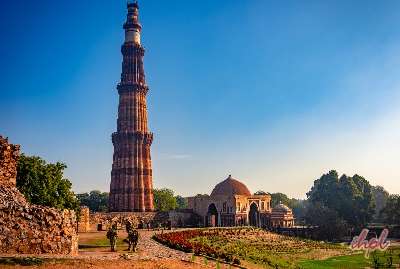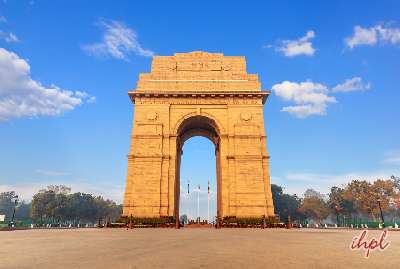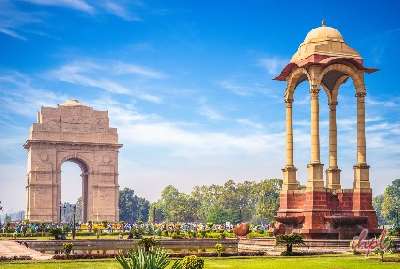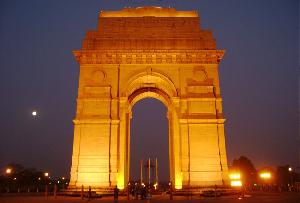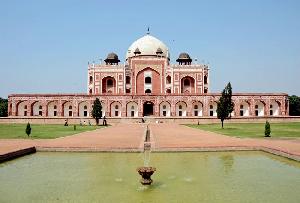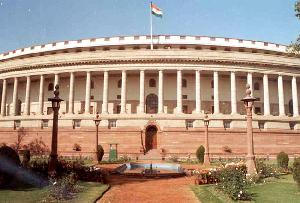Facing west, the Jama Masjid is covered on three sides with open arched colonnades with a tower like gateway in the center. Also called Masjid-I-Jahanuma or the ‘mosque commanding view of the world’, the Jama Masjid is a constructional wonder with alternating strips of red sandstone and marble.
The mosque owes much of the respect associated with it to the relics of Mohammad, which it houses. These include Quran written on deerskin, a red beard-hair of the prophet, his sandals and his footprint, embedded in a marble slab, all of which are still preserved.
Architecturally, the Jama Masjid is similar to many other mosques that the Emperor of Architecture, Shah Jahan built all around his realm. These include mosques by the same name in cities like Ajmer, Agra and a number of others. The courtyard of the Jama Masjid, which is completely built of red sandstone, is accessible from the east, north and south by three different flights of stairs. These steps are used to house markets, entertainers as well as food stalls. The mosque also housed a Madrassah near the southern side of the mosque which had been pulled down after the Sepoy Mutiny of 1857.
India is known for her unity in diversity. People belonging to different faiths and different mental thoughts co-exist in the country with perfect harmony within themselves, contributing thereby to the strength of the Indian fabric in general. Their places of worship too, are thus sacred not just to themselves but to their fellow-countrymen as well, irrespective of the faith they follow. One of these is the Jama Masjid in Delhi, built by the Mughal emperor Shah Jahan in 1656. Generally considered to be the largest and most respected mosque in India, the Jama Masjid is one of the most famous landmarks of the country, symbolizing for the country’s Muslim population a guide to the religious doctrines.
Checkout: Delhi Tour Packages
History:
Showcasing India’s fine blend of religions, the Jama Masjid is one of the greatest examples of the fine fabric of secularism that envelopes the entirety of India. The mosque which is part of the historic complex of the Red Fort in Delhi draws countless of visitors each day, many of whom are drawn to this revered site by the history of the Jama Masjid.
The mosque was built by Shahjahan inside his fort city of Shahjahanabad or the Red Fort as it is known today. Planned and designed by the brilliant Mughal architect Ostad Khalil, the mosque was built at a cost that was around 10 crores, a colossal figure in the medieval era, even considering the grandeur of the enterprise. The mosque was begun in 1650 which saw over 5,000 workers involved in the labor which was to see the largest mosque in India completed six years after its foundation stone was laid.
The mosque in the medieval period had certain areas restricted for the use of the emperor and the other members of the royal family. These included the largest and the highest gate of the complex located on the eastern side of the Jama Masjid.
Besides its obvious religious significance, the mosque was also used for housing a Madrassah near its southern side, which was pulled down after the Sepoy Mutiny of 1857.
Much of the respect that is accorded to the Jama Masjid is due to the fact that the mosque is famous for housing some of the notable relics of Prophet Mohammad, which includes, the Quran written on deerskin, a red beard-hair of the prophet, his sandals and his footprint, embedded in a marble slab, all of which are still preserved
Annual Events:
The Jama Masjid symbolizes to most Indians an amalgamation of religion and history where each strives to bring in a sense of unity not just amongst the Muslims but also amongst their non-Islamic brethren. The mosque which was built by Shah Jahan was originally constructed as part of the Mughal emperor’s newly constructed capital of Shahjahanabad or the Red Fort as it is known as today. At that period, the mosque had special chambers that were dedicated to the prayer sessions of the emperor and the other members of the royal family. The importance that the Jama Masjid enjoyed during the period, has, however, not diminished today and is still strongly held on to just like the other traditions and customs that are still associated with the various annual events of the Jama Masjid.
One of the most important features of the mosque is that the chief cleric of the mosque has always been till now the direct descendant of the chief cleric who was invited by Shah Jahan to come to Delhi from Bukhara at the time of the inauguration of the Jama Masjid in 1635. It is perhaps this authenticity that makes the Chief Cleric of the Jama Masjid one of the most respected figures amongst India’s Islamic brethren. Thus, the celebration of important Islamic festivals finds their greatest expressions on the premises of the Jama Masjid. These include the important Muslim festivals like Id-ul-Fitr and Id-ul-Zoha when thousands of followers of Islam throng the premises of the Jama Masjid to offer their prayers on its auspicious grounds.
Fast – Facts:
Location
Located on Netaji Subhash Marg, Old Delhi, the Jama Masjid is at a distance of just around 500 meters west of the Red Fort is located close to a number of other tourist attractions of Delhi.
Built by
Built by the emperor of architecture, Shahjahan inside his newly built capital Shahjahanabad, the Jama Masjid was built in 1656.
Nature & Architectural style
Showcasing a rich influence of Persian architecture, the Jama Masjid is one of the oldest mosques of India.
Timings
The summer timings at the Jama Masjid are 7 a.m. to 12.15 p.m and again from 1.45 p.m. to till sunset. The winter timings are from 8.30 am-12.15 pm & again from 1.45 pm till sunset.
Admission charges
Though the entrance to the mosque is not charged and can be accessed at any time except during the time of prayers by people of all religions, photography is charged at a rate of 1.N.R. 20 for Indian visitors and I.N.R. 150 for foreigners.
How to Reach:
Located in the heart of the city of Old Delhi, reaching the Jama Masjid can be easily accomplished as it is well-connected by:
Nearest airport – Indira Gandhi International Airport
Nearest railway station – Old Delhi Railway Station
Nearest metro station – Kashmir Gate
Nearby Attractions:
One of the most respected places of religious worship in the entirety of the country as well as the oldest mosque in India, the Jama Masjid is one of the leading tourist attractions of Delhi, popular not just amongst the followers of Islam but also believers of other religions. The mosque, which is located inside the complex of the Red Fort or Shahjahanabad as it was known as before, has a number of nearby attractions to offer the visitors to the site in addition to its own pristine beauty.
Nearby Attractions:
Red Fort
One of the most important symbols of India’s sovereign democracy, the Red Fort was once the capital of the Mughal dynasty after it was built by Shahjahan as his capital called Shahjahanabad. A huge complex showcasing life as it was in during the Golden Rule of the Mughals, the Red Fort is a must-visit while on a trip to Delhi.
Qutub Minar
Another important symbol of the historic city of Delhi, the Qutub Minar is an iron tower built in 1199 by Qutubuddin Aibak, which has till today, not shown a single speck of rust.
Chandni Chowk
One of the important bazaars of Shahjahan’s Red Fort, this historic bazaar is today, one of the oldest trading centers in northern India, showcasing some of India’s finest examples in terms of jewelry, fabrics, handicrafts as well as an array of mouthwatering roadside snacks.
India Gate
Built as a memorial for the Indian soldiers who were killed in the 1st World War, the India Gate is an imposing structure that arches to give a glimpse of the red sandstone structure of the Red Fort.




